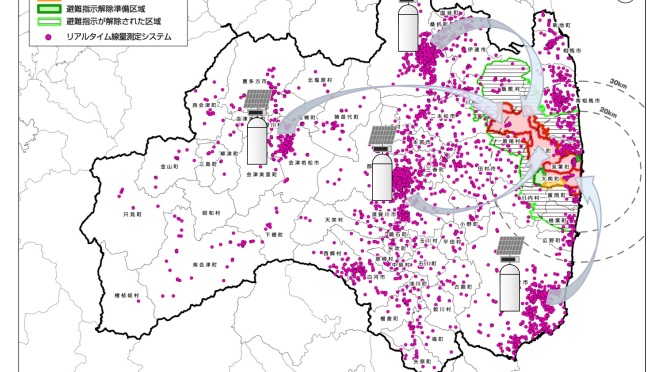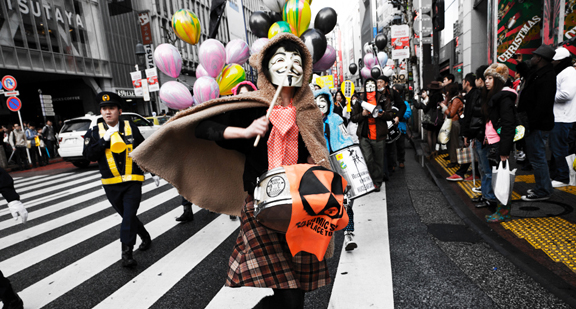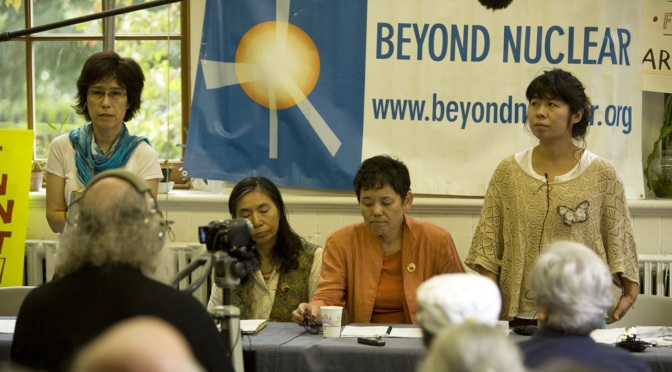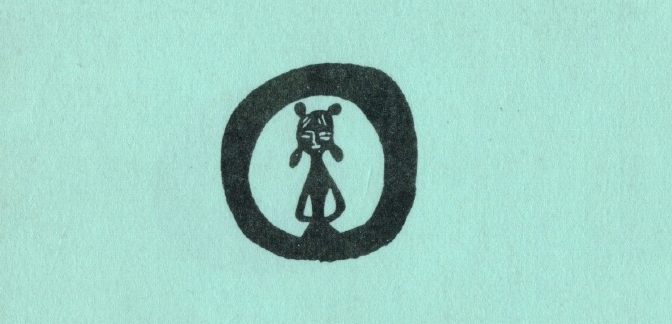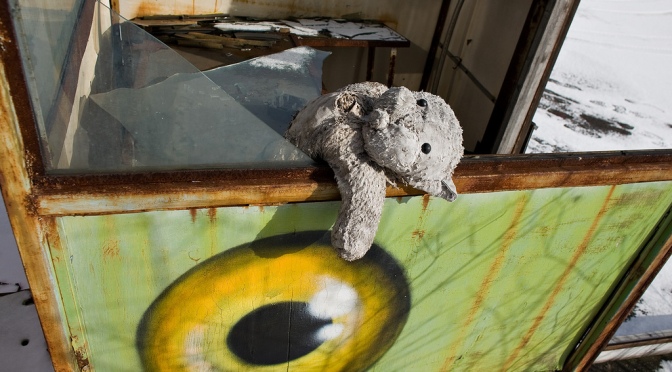ISSUE
On March 20th, 2018 the Nuclear Regulation Authority (NRA) announced plans to remove approximately 2,400, or 66%, of the 3,600 radiation monitoring posts in Fukushima prefecture by March 2021.[1] This was announced as part of an effort to refocus government radiation monitoring on the evacuation zone.

Note on Evacuation Zones

“Non-mandatory evacuees” refers to people who evacuated from outside zone B (shaded yellow). The national government, Fukushima prefecture, and TEPCO have recognized non-mandatory evacuees from 23 municipalities in the prefecture.[2] All other non-mandatory evacuees do not qualify for state aid. For maps providing an overview of fallout, see the following: ① Soil contamination levels: see the most recent map from the Eastern Japan Soil Contamination Project (EN) (日本語); Chernobyl comparison map (EN);[3] ② Atmospheric radiation levels: see radiation plume maps created by Yukio Hayakawa (9/11/2011; 2/1/2013) and the Safecast tile map.
“Mandatory evacuees” refers to people who evacuated from zone B. State-mandated evacuation happened in waves. Evacuation from Iitate village, Katsurao village, northern Namie town, and part of Kawamata town was not mandatory until May 2011. Areas only shaded yellow were told to prepare to evacuate—they were not mandated to evacuate by the national government, but may have been advised to do so by their municipal government. Evacuation orders have been lifted for all areas within zone B besides areas 1-3. As evacuation orders have been lifted and aid to evacuees from these areas has been cut off, some evacuees find themselves in a state of unrecognized displacement similar to that experienced by non-mandatory evacuees.
Note on Radiation Monitoring System in Fukushima Prefecture

Like other mass exposure events,[4] the Fukushima nuclear disaster has been characterized by the delayed release of information, the falsification or inadequate collection of data, underestimating the scale of damage, and the coordinated production of pseudoscientific misinformation.[5] The government has sought to maintain its control of the ensuing struggle over health, wages, and welfare by controlling information and paternalistically discrediting forms of knowledge or evidence that threaten its narrative. Slashing monitoring post infrastructure is another development in this pattern: it further consolidates the government’s position as the only entity with the right to know what radiation levels are, and the only entity acknowledged as being capable of assessing the circumstances, while displacing risks onto the public by symbolically shrinking the scale of the disaster.
Plans to remove these 2,400 monitoring posts are part of a broader reduction in government measures to address the nuclear disaster. Not unlike the 2008 bailout of American finance capital, the Japanese government has chosen to bail out TEPCO and pass on the risks and consequences of the nuclear disaster onto the public.[6] ❶ Health. In April 2016, residents were given the choice to opt out of the the Fukushima prefectural health survey (県民健康調査)—the only large-scale study being conducted on the health effects of the disaster.[7] Though framed as an implementation of informed consent, antinuclear groups have voiced concerns that this is part of “self-responsibility” (自己責任) discourse, which has framed reductions in government protections and services as protecting residents’ freedom of choice.[8] In December 2016, a member of the Oversight Committee for the survey suddenly proposed adding an external international oversight committee to the survey to “deepen prefectural residents’ understanding.” This followed a convention of experts from international agencies such as the ICRP, UNSCEAR, and WHO in Fukushima city, and appeared to be a request to implement their recommendations to reduce the scale of the survey and strengthen their oversight of it.[9] These organizations have played key roles in downplaying the health consequences of the Chernobyl nuclear disaster.[10] ❷ Housing. In March 2017, Fukushima prefecture cut off housing subsidies to non-mandatory evacuees—the only form of government support they were offered, and even then only to evacuees from Fukushima prefecture.[11] Many non-mandatory evacuees are barely making ends meet from a combination of mortgages on the homes they left behind, doubled rents for family members living separately, and gender-based employment discrimination affecting evacuee women, who are reported to constitute 60% of non-mandatory evacuees.[12] A month after housing aid was cut off, the Reconstruction Agency stopped counting non-mandatory evacuees in evacuee statistics, making the full scale and consequences of displacement from the nuclear disaster more difficult to assess.[13] Aid to mandatory evacuees from areas where evacuation orders were lifted were cut off just one year later, in March 2018.[14] Both non-mandatory and mandatory evacuees have reported being sued for remaining in evacuation housing.[15] ❸ Wages. In January 2018, citing improved working conditions, TEPCO announced that from April, risk allowances (危険手当) paid to contractors for decommissioning work at the Fukushima Daiichi nuclear power plant would be reduced by as much as 50 percent.[16] It has subsequently been reported that workers are receiving risk allowances as meager as 3000 yen (30 USD) per day (they should be receiving the full amount, which was 20,000 yen (200 USD)).[17] As numerous reports have documented, these allowances are mostly skimmed off by general contractors and their direct subcontractors, who then hire further subcontractors to do the actual work.[18] In this instance, it appears that the reduction in risk allowances has been passed off onto workers. There are also concerns that TEPCO’s assertion that “working conditions have improved” at Fukushima Daiichi will lead to justifying the use of lighter protective gear—in other words, that workers will be paid less to work in more dangerous conditions.[19]
EXPLANATIONS
The NRA has provided several justifications for its plans to reduce radiation monitoring infrastructure in Fukushima prefecture:
- Radiation levels are generally low and stable, and decontamination and recovery are progressing, so there is little need to continue radiation monitoring on a large scale.[20]
- The reduction of the real-time radiation dose monitoring system will be part of an effort to refocus attention on the recovery of areas where evacuation orders have been lifted, and removed monitoring posts “will be used for such things as fulfilling requests for monitoring posts by municipalities” in such areas.[21]
- The national government will discontinue its recovery budget in March 2021.[22]
SCARCITY NARRATIVES
Monitoring Posts Will Not Be Relocated
When explaining the shift to the Nuclear Regulatory Agency on March 20th, 2018, Matsuji Takeyama (head of the Monitoring Information Division) emphasized that there would still be a need for radiation monitoring at key “key recovery points” (fukkō kyoten) in areas where evacuation orders have been lifted. However, when he was asked by another committee member how many monitoring posts would be appropriate, he replied that there is no specific goal. Rather, it would be up to municipal governments to request that monitoring posts be placed around schools or public locations.[23] FOIA requests and negotiations with the NRA by the Citizens’ Group for Continued Radiation Monitoring (CGCRM) have revealed that there are currently no such requests. This suggests that rather than redistributing existing infrastructure to suit new community needs, the NRA plans to refocus radiation monitoring on the Fukushima coast simply by eliminating most publicly accessible monitoring infrastructure in the rest of the prefecture.
Costs
According to the Monitoring and Information Division (監視情報課) of the Nuclear Regulation Authority, annual maintenance costs for the real-time radiation dose monitoring system total 500 million yen.[24] Most maintenance costs are due to repairs. Though English-language news reports on the subject have led with discussion of 4,000 monitoring post malfunctions, this number appears to refer to initial adjustments made when the monitoring posts were first installed.[25] The total cost of all radiation monitoring activities is approximately 1 billion yen annually, and mostly comes out of the environmental radiation measuring agency budget (環境放射線測定等庁費). By comparison, the Reconstruction Agency’s 2018 budget allotts 5 billion yen to support tourism (観光復興関連事業), 69 billion yen to build key recovery spots in areas where evacuation orders have been lifted (特定復興再生拠点整備事業), and 209 billion yen on recovery roads (復興道路・復興支援道路の整備).[26] The Reconstruction Agency (復興庁) has allotted a total of 1.6 trillion yen for recovery efforts in 2018. Costs to maintain the real-time radiation dose monitoring system amount to 0.03% of that budget.
THE POLITICS OF RADIATION MAPS
Averaging Unevenness
In materials for its February 10, 2016 meeting, the NRA demonstrates the stability of low radiation levels by averaging data from all real-time radiation monitoring posts in a given area, the smallest of which is 475 square miles (1,200km2). This is supplemented by displaying the monthly averages for one real-time monitoring post from each area. However, one cannot assume that residents spend equal amounts of time in hotspots and areas with lower fallout levels, nor that they regularly commute across a 475 square-mile area. Everyday life happens on a smaller scale.[27] Furthermore, it is unclear why one monitoring post is being used to represent levels for regions where radiation levels can vary from 0.08~0.8µSv/hr, or even in areas with a range of 0.06~0.23µSv/hr.

Safecast Map (May 18, 2018):

While the Safecast map documents significant variation in air dose rates, especially in central Fukushima and Tochigi prefecture, there is often significant variation at smaller scales as well. This 2017 map of Hobara town, Date city has readings ranging from 0.09~0.35µSv/hr (0.5~1.8mSv/yr).

Above the Limit
There are also many places outside of the mandatory evacuation zone where radiation levels are higher than the government standard of 0.23µSv/hr.[28] One resident of Hobara town, Date city stated that radiation levels in the neighborhood have remained at 0.3µSv/hr.[29] We can also see from the Safecast map that radiation levels above the post-disaster standard of 0.23µSv/hr are not limited to Fukushima prefecture, nor are air dose rates above the 1991 Chernobyl law standard of 1 mSv/year (2.74µSv/day = 0.19µSv/yr).[30] One should also note that the devices used to create these maps only measure gamma radiation, and moreover do not account for internal radiation exposure from inhalation and consumption of radioactive food. Cesium-137, Cs-134, Strontium-90, Iodine-131, and Plutonium isotopes emit beta particles in addition to gamma radiation, and Plutonium also emits alpha particles. These are especially damaging when they get inside the body, as they emit intense radiation until the isotope leaves the body (anywhere from a few days to several years, depending on the isotope).
A map compiled by the Eastern Japan Soil Contamination Project suggests that soil contamination levels across the fallout area, especially in Fukushima, Tochigi, Gunma, Miyagi, and Chiba prefectures, remain high. Greenpeace also reports that despite decontamination, Iitate village and Namie town continue to have radiation levels well above the government standard.
Stability
According to TEPCO, the Fukushima Daiichi nuclear power plant continues to release 91,000 Becquerels of radiation per hour (as of April 25, 2018). Though plant decommissioning is scheduled to end in 40 years, officials have admitted that decommissioning at that pace is not feasible, with some estimating that it could take as long as 200 years before radiation levels subside enough to allow work to progress.[31] So long as decommissioning is not complete, the risk of another monumental atmospheric release of radiation remains a possibility.[32]
The routine way in which the government has continued to hide information and leave residents to be exposed to radiation during accidents was explained well by Ms. Wada, a resident of Harano area:
During the nuclear accident, residents were exposed to serious levels of radiation because SPEEDI data was kept from us. I think there has been no trace of regret or change about this from the national government. And there have been frequent accidents at the Monju plant, and there was the JCO accident [1999]. TEPCO has also hidden problems many times. We don’t know how often because of what has not been made public. And during such incidents, every time, there has been a pattern where information has been hidden from residents and they have been exposed to radiation.
Explosions have happened at incinerators (焼却炉). At incinerators burning [radioactive] waste from decontamination. There was an explosion [at such a facility] in Samegawa village. A resident has testified that the radiation levels of the monitoring post nearby increased, but they were not able to document any evidence, so the matter was left unsettled. And at the incinerator in Tomioka town, a small fire broke out. There were issues in Warabidaira in Iitate village, and [the facility there] has been stopped for 5 months. At an intermediate treatment facility in Kōriyama city, a fire broke out in the storage area for highly contaminated materials. It was quite a scene, but that time, too, residents were not told anything. One person was working in their field right next to it. I negotiated with the Ministry of Environment [concerning this matter] multiple times, but not a single warning was issued. In Namie town, Minamisōma city, and Date city, there have been wildfires. In those instances as well, residents were not notified. There are also disabled persons who cannot hear, and who need to check [circumstances] with their eyes. So I think the monitoring posts are absolutely necessary.
[…] You have said that after removing the monitoring posts, you would like to have an exchange with residents and decide what to do, but over the course of these events we have unfortunately had to learn that if something happens, the government will not protect us. How are we supposed to believe you?[33]
WHOSE RIGHT TO KNOW: GOVERNMENT PATERNALISM
Because radiation is imperceptible to the five senses, insofar as people are driven into remaining in the fallout zone,[34] maps can be important sources of information for reducing exposure levels. There is no safe level of radiation exposure. It is cumulative, and the probability of developing an illness directly increases with every increase in exposure.[35] Insofar as the government continues to coerce residents to return or remain in the fallout zone, the public needs accessible information on their condition in real-time. As Terumi Kataoka from CGCRM said in an interview, “Why is our right to know being taken away when we are being forced to be exposed to radiation?”[36]
Matsuji Takeyama, head of the Monitoring Information Division[37] of the NRA, has explained the purpose of the real-time monitoring system:
Rather than assessing the situation, the main purpose of the system is for people who are living there to instantly see and understand [radiation levels in the area]. So I believe that moving forward, it is not necessary to have so many [real-time radiation dose monitoring posts].[38]
He assumed a similar stance in April 16, 2018 negotiations with CGCRM:
The reason we are removing [the monitoring posts] is because the radiation levels have stabilized enough. That is speaking scientifically. […] However, we understand that you are worried, and, uh, I think it is a question of emotions. I think there is unease, so… In principle, where [radiation levels are] low, [the monitoring posts] serve no purpose—are not necessary, but we will ultimately decide after listening to your opinions. […] We explained our policy. We will make the final decision after talking with municipal governments.
(A mother who evacuated from Iwaki city provided a good counterargument):
[…] The first thing I would like to say is that you have been using the words, “scientifically, scientifically,” but [saying that something is] “low enough” is not scientific, right? To what is it “low enough” in comparison? If you want to speak of science, then that means continuously comparing the [current] radiation levels to pre-accident levels. […] I don’t think [radiation levels] are stable by any means, or that they are the level they were before. […] That is why I have continued to evacuate with my children. I don’t think you should use the unscientific phrase, “low enough,” and I can’t believe that you plan to remove [the monitoring posts] because “[radiation levels] are stable” even though circumstances are still completely different from pre-accident conditions. Also, you said, “[we will hold] explanatory meetings [with residents] moving forward.” You said, “[you will] get [residents] to understand.” I have been to many explanatory meetings until now, but I always had the bitter experience of having [a policy] forced on me because “it’s already been decided.” Please listen to the voices of those who have been directly affected—to us and the municipalities.
Takeyama’s statement suggests that residents’ efforts to understand their own environmental circumstances do not count as assessments—that they are neither agentive nor important. His statement assumes that the very action of seeing and interpreting radiation levels in one’s immediate surroundings is not a way that residents assess the situation in which they are living. It furthermore suggests that he does not value residents’ right to access information about potentially harmful circumstances in which they are living. He presumes that the only entity capable of making assessments is the NRA, and not the people who are living with the consequences of government and corporate negligence. Such paternalism was also present at other points during the negotiations, where Takeyama repeatedly offered lukewarm acknowledgements of residents’ statements while emphasizing that “scientifically” speaking, radiation levels were “stable and low” and that the NRA would abide by its removal policy.
Woman from Kōriyama city:
I believe this has been explained several times already, but phrases such as, “prefectural residents should understand correctly to prevent unnecessary worry,” appear 20 times in these materials. So then I think, what are we? I am concerned that we are being taken as prefectural residents who do not “understand correctly” and are “unnecessarily worried.” What do you think about this point?
Matsuji Takeyama:
I don’t particularly think that it is strange that you feel worried. Of course, the radiation levels have decreased from high levels, but I understand that you are worried. […]
This dismissiveness follows a trend present since the disaster’s inception, where a coordinated effort by the Cabinet; Ministry of Education, Culture, Science, and Technology; the Ministry of Health, Labor, and Welfare; Fukushima prefecture; TEPCO; mass media; and appointed intellectuals has dismissed residents’ insistence on their right to knowledge and information by characterizing them as “hysterical,” “spreading harmful rumors,” “emotional,” and “subjective.”[39] Thus, while post-disaster government pamphlets about radiation emphasized the public’s need to “learn correctly,”[40] the presentation of evidence that contradicts its narrative of safety has been characterized as “harmful rumor.” For these government bodies, “knowledge” seems to mean feeling reassured that the circumstances residents are being coerced into are tolerable, not harmful. As scholars such as Ann Kimura have pointed out, the misogynistic idea that women are incapable of rational thought—not to mention the idea that rationalism constitutes the only valid form of thought—have been instrumental in the “harmful rumor” discourse.
Women have resisted such narratives by validating different emotional responses to radioactive fallout and emphasizing the logical nature of such feelings. For example, during negotiations Terumi Kataoka stated:
In other words, decommissioning is not over—it’s just begun—and moreover, the declaration of nuclear emergency (原子炉緊急事態宣言) still hasn’t been lifted. And yet in spite of this, why do you have to do something unreasonable, something illogical? Why do you have to take the monitoring posts from our daily lives? This is the voice of residents. Additionally, there have been many negotiations with the national government and prefectural government until now, but the thing that is absolutely different about this one is that, starting with Fukushima prefecture, municipal governments from the prefecture are saying that it is too sudden, or that they do not want [the removal]. These kinds of things are really being voiced here [pointing to NRA report]. So in spite of all of that, why are you lining up only these same explanations, that you want to get rid of residents’ “unnecessary anxiety” (無用な不安), or to [have us] “understand correctly” (正しく理解してもらう)? I really don’t understand it. I absolutely don’t understand it. Is it strange for us to feel uneasy? The nuclear accident that was supposed to never occur, happened. It is natural to feel uneasy. I think it is strange not to be worried about that. We have been living in this kind of circumstance every day for seven years. And yet you are going to take away the monitoring posts that we look at wondering, “What is the situation like today?” We do not understand this at all.
Government Reassurance
The NRA has reassured residents opposed to the removal of monitoring posts by pointing out that it has a separate radiation monitoring system for emergency situations (consisting of 51 monitoring posts), and that it will take appropriate steps in the event of an emergency. However, these monitoring posts do not visually display their data. The 3,000 real-time radiation monitors and the 600 portable radiation monitors in the prefecture are the only meters that display their readings. Yumi Chiba (CGCRM) has expressed that the NRA’s emergency plan is unrealistic:
As people who have experienced the panic of that time [during the nuclear meltdown], I cannot express how distant the portable radiation monitoring posts—placed every 5km—are for us. You said that we could borrow portable devices [i.e. geiger counters] [in the event of an emergency], but having experienced such a situation before, we can tell you that should such a situation arise, it is not going to be possible for us to run into town hall [to ask for a geiger counter]. That is the reality.
A mother from the Aizu region said,
We didn’t have geiger counters in 2011. People individually bought them, or didn’t. They were out of stock, so it was hard to get them, and SPEEDI turned out to be of no use. And once we finally got a geiger counter, the plume had already passed. What are we supposed to do if something like that happens again?
Why Trust Government Radiation Monitoring Posts?
Prior to the NRA’s announcement, the sentiment that the government radiation monitoring system was untrustworthy was widespread among evacuees and those with antinuclear sentiments. Several studies were conducted confirming that government monitoring posts were systematically displaying figures 40%-60% lower than readings that could be taken with geiger counters.[41] In some cases, monitoring posts were installed with sheets of iron under them, effectively preventing gamma rays from the soil (the main source of radiation) from being measured. In other cases, the immediate surroundings of monitoring posts were decontaminated.[42] Much like the prefectural health survey, the radiation monitoring system is both flawed and the only solution that the government appears willing to offer. Even as both instruments produce the appearance of safety and a gradual decline in the disaster’s effects, their reduction would further expand the realm of unknowns, making it increasingly difficult to establish when potentially harmful incidents occur, their consequences, and who is responsible.
SYMBOLIC REDUCTION
“Chernobyl did not simply disappear; it was extinguished in waves as a result of particular types of framing that set the health effects of the fallout outside the scope of immediate concern. Before that, the greatest public salience of Chernobyl did not begin until about three years after the accident, a period of great political transformation only two years before the collapse of the Soviet Union” —Olga Kuchinskaya, The Politics of Invisibility: Public Knowledge about Radiation Health Effects, p.66.
Underestimating the scope and consequences of radiation fallout has been a consistent characteristic of the nuclear industry and associated research on the health effects of radiation exposure. In particular, the similarities between the reductions taking place in Japan and the Belarussian government’s management of the 1986 Chernobyl nuclear disaster are striking.
After the Soviet Union collapsed in 1991, the newly formed Belarus implemented fairly comprehensive measures to address the consequences of the nuclear disaster. However, these measures ended up costing a full 20% of the national budget. In 1993, a special working group was formed to revise its policies.[43] Soon after, government measures to address the disasters’ consequences began to shrink, and began to emphasize economic recovery. The government declared an end to emergency measures and said that residents needed to learn to live with radiation.[44] It changed the criteria for determining radiation doses, so that instead of being measured, they were estimated through controversial and non-transparent techniques. Areas where average doses were estimated to be under 1 mSv/year lost their social protections, and had no additional protective measures.[45] After 1996, the area deemed contaminated enough to matter was gradually shrunk through changes in evaluative criteria.[46] In 2003, a presidential decree relocated all Chernobyl-related institutions to Gomel on the premise that research should be concentrated “in the most affected area.”[47] This resulted in a drastic reduction in personnel (from 165 to 75 faculty), and the loss of continuity in data collection and analysis, making it difficult to more fully assess the impacts of the disaster.
As sociologist Olga Kuchinskaya notes, infrastructures and practices created to address the effects of radiation often come to stand in for the presence of radiation itself. She writes, “Administrative practices meant to mitigate various effects of radioactive contamination thus come to constitute the visibility of the problem of radioactive contamination; they become the signs of the contamination.”[48]
It seems likely that removing two-thirds of the public radiation monitoring infrastructure in Fukushima prefecture will be instrumental in reshaping the landscape into one where radioactive fallout is not an active concern. Now that many of the bags of radioactive soil that were scattered across the prefecture have been transferred to storage facilities, the radiation monitoring posts are the primary reminder in the landscape that radioactive fallout is still present, and that the stability of the Fukushima Daiichi nuclear power plant is far from guaranteed. As one mother put it, “Once even the monitoring posts are gone, it will really be as though [the nuclear disaster] never happened. People’s feelings will fade away.”[48.5] The radiation monitoring posts thus also play an important symbolic role, and this drastic reduction would mean another premature reframing of the disaster as coming to a neat close.
CONCERNING “HARMFUL RUMOR”
The author does not intend to suggest that residents in the fallout zone, especially in Fukushima prefecture, have not been stigmatized, discriminated against, or that people in primary industries have not suffered from consumer politics in the wake of the nuclear disaster. In fact, the systematic prevalence of bullying has been an important force pushing evacuees back to more dangerous areas, along with government and academic gaslighting and reductions in aid. The question is why bullying and stigmatization is so prevalent. How are people taught to feel about radiation exposure, and how are they directed to act upon those feelings?
Making discussion of radiation exposure a taboo subject turns it into something shameful and something to fear. It also turns the blatantly obvious fact that the government has allowed some people to be exposed to more radiation than others—illustrated, for example, by the April 2011 notice to schools in Fukushima prefecture that it would consider 20 mSv/year of exposure admissible there, while the standard for the rest of the country remained 1 mSv/year[49]—into an issue of “self-responsibility” for which victims can be blamed. In other words, the government itself quickly assumed a discriminatory stance in its post-disaster measures, and then turned dissent against that discrimination into a taboo subject by declaring it “harmful rumor” and then spreading misinformation about radiation. It is not difficult to infer that this enforces an unspoken understanding that those who resist discrimination from the state (by evacuating, for example) should be punished. And this is in fact what is happening. School children who bullied their classmates for wearing masks or otherwise protecting themselves from internal radiation exposure were often reported saying, “You think you’re the only one who gets to be spared? (お前だけ助かる気か?)” “Culture of poverty”-type narratives of mandatory evacuees mismanaging compensation money also stem from the logic that they have not experienced any form of structural discrimination. We need to think more about how the atmosphere created by government policies and narratives spread by the media relates to widespread bullying and stigmatization of evacuees.
Bullying also seems undoubtedly tied up with eugenicism and the stranglehold that ableism, transphobia, and misogyny continue to have on social life in Japan. The forced sterilization of the disabled is still legal, though there is more public outcry against it recently, and transgender people are required to undergo sterilization to gain legal recognition.[50] Many women are worried they will face marriage discrimination for having been exposed to radiation—in other words, that they will be refused marriage because other people do not want to risk having a disabled child.[51]
CONCLUSION
As the Fukushima nuclear disaster progresses, unevenness, the systematic production of ignorance and uncertainty, and the connections between containment and discrimination remain central issues. From the standpoint of care work, it seems clear that we need to think much more deeply about who is vulnerable and what we can do to make sure their dignity is respected. Even while the Japanese government and “nuclear village” have done serious damage in the Fukushima nuclear disaster, mainstream antinuclear narratives mostly ignore nuclear workers, farmers, fishermen, woodcutters, working-class women, and they fail to offer serious answers about how to create a national economy that does not require the destruction of rural communities, making them vulnerable to toxic facilities.
Liberal antinuclear feminisms have played a critical role in resistance to these trends. They have created discourses that emphasize validation of emotional/experiential truths, articulated evacuation as a human right, created community-controlled radiation monitoring technology, and created mental and physical health care through support groups and a vast network of volunteer-based recuperation camps.[52] These efforts have created space to struggle against the Japanese state’s maneuvers to pretend that the effects of the nuclear disaster have been safely contained within administrative boundaries. Most notably, widespread mobilization by women, especially mothers, led to the passing of the Disaster Victims’ Support Act (被災者支援法) in 2012, though it was subsequently mostly gutted.[53]
We need to keep thinking about how these feminisms can connect with nuclear labor organizing and social movements by people in primary industries who have been disenfranchised by “modernizing” economic policies, to create a more transformative antinuclear politics.
TIMELINE
August 2, 2011: Plans for radiation monitoring announced. Real-time radiation dose monitoring system is included in these plans: “establish a real-time radiation monitoring system, installing integrated dosimeters able to send data in schools, parks, etc. in Fukushima prefecture.”[54]
February 21, 2012: MEXT radiation mapping webpage, based on data from the “real-time radiation monitoring system,” comes online. There are 2,700 monitoring posts comprising the real-time monitoring system at this time.[55]
December 2013: An additional 336 real-time radiation monitoring posts and 33 portable monitoring posts installed in coastal Fukushima.[56]
October 6, 2015: the Nuclear Regulation Authority (原子力規制委員会) instructs the Nuclear Regulation Agency (原子力規制庁) to issue a summary of radiation monitoring activities since the Fukushima nuclear disaster of March 2011, and to make necessary revisions to the monitoring system.[57]
Early 2016: 38 monitoring posts transferred from relatively low-level radiation areas to (presumably) the former evacuation zone.
February 10, 2016: The Nuclear Regulation Agency reported back to the NRA about the monitoring results and their subsequent revisions to the monitoring system.
March 2017: 39 monitoring posts removed from across the prefecture. The NRA has yet to clarify whether they have been reinstalled elsewhere, as residents were informed they would be.[58]
December 2017: the Nuclear Regulation Agency solicited opinions from municipal governments on the revisions.
March 20, 2018: the NRA announced its plans to revise the monitoring system.
April 2018: Citizens’ Group for Continued Radiation Monitoring established. They deliver letters with demands to the mayors of Kōriyama, Fukushima city, Iwaki city (April), Date city, Aizuwakamatsu city, Miharu town, and Shirakawa city (May).
April 16, 2018: CGCRM delivers letter with demands to the Nuclear Regulation Authority.
<July 13, 2018: CGCRM plans to deliver further demands to the Nuclear Regulation Authority>
[1]Matsuji Takeyama, head of the Monitoring Information Division of the NRA, specifies that real-time radiation monitoring posts displaying radiation levels of less than 0.23µSv/hr will be removed, and states that there are approximately 2,400 such monitoring posts. See http://www.nsr.go.jp/data/000224599.pdf. Portable monitoring posts have a distribution of one post per 10km in the westernmost Aizu region, one post per 5km in other regions, and 80 posts near the Fukushima Daiichi nuclear power plant. See http://www.nsr.go.jp/data/000139313.pdf, p.1.
[2]http://www.mext.go.jp/b_menu/shingi/chousa/kaihatu/016/shiryo/__icsFiles/afieldfile/2012/02/23/1317043_4_1.pdf
[3] You can find more information on this project here (EN), and an explanation of what the different radiation levels mean here (日本語).
[4] C.f. the Flint water crisis (see as well this report); the Bhopal disaster (1984; what some call the world’s worst industrial disaster, which took place in India); Church Rock (1979; the largest radioactive disaster in the United States); the Chernobyl nuclear disaster (1986).
[5] For delayed release of information, see SPEEDI issues and TEPCO’s confirmation that it covered up the meltdown of three reactors. For falsification, see discussions of radiation exposure records for nuclear workers. For an overview of inadequate data collection and misinformation, see Piers Williamson’s comprehensive article on thyroid cancer screenings by Fukushima Medical University and p.44-7 in the 2017 report, Genpatsu Zero Shakai e no Michi: Datsu Genshiryoku Seisaku no Jitsugen no Tame Ni. As this pertains to decontamination and decommissioning workers, see Hibaku Rōdō wo Kangaeru Nettowāku, Josen Rōdō, p.56-7; Genpatsu Jiko to Hibaku Rōdō.
[6] “Special Report – Inside Tepco’s Bailout: Japan Inc Saves Its Own” Reuters, 5/23/2011. For more on the 2008 financial crisis, c.f. We All Fall Down: the American Mortgage Crisis (2009); Elvin Wyly, C. S. Ponder, Pierson Nettling, Bosco Ho, Sophie Ellen Fung, Zachary Liebowitz, and Dan Hammel, “New Racial Meanings of Housing in America.” American Quarterly 64(3) 2012: 571-604.
[7] 坂本充孝「子の甲状腺検査/縮小は是か/6年目の被災地/うずまく議論」東京新聞 1/7/2017. See also 鈴木博喜 「【県民健康調査】「県民の理解深めたい」。星座長が第三者委の設置を提案。背景に日本財団の提言、検査体制縮小の布石か~甲状腺ガンは9人増えて183人に」民の声新聞 12/28/2016.
[8] C.f.「甲状腺検査のあり方」検討はじまる〜国際がん研究機関」Our Planet TV 10/25/2017; 「第53回 甲状腺検査縮小求める「県民の声」なし」Days Japan 10/20/2016.
[9] 坂本充孝「子の甲状腺検査/縮小は是か/6年目の被災地/うずまく議論」東京新聞 1/7/2017. See (English) (日本語) for convention participants.
[10] http://taminokoeshimbun.blog.fc2.com/blog-entry-99.html; http://www.tokyo-np.co.jp/article/feature/tohokujisin/fukushima_report/list/CK2017011702000158.html. For the role of ICRP, UNSCEAR, WHO in the underestimation of health effects from the Chernobyl nuclear disaster, see Kuchinskaya, The Politics of Invisibility, p.117-126; Alexey Nesterenko, Vassily Nesterenko, and Alexey Yablokov, “Chapter II. Consequences of the Chernobyl Catastrophe for Public Health,” in Chernobyl: Consequences of the Catastrophe for People and the Environment, New York: New York Academy of Sciences, 2009. Vassily Nesterenko was the former head of the Institute of Nuclear Energy, and former chief designer of mobile nuclear power plant Pamir (Kuchinskaya, p.109).
[11] Non-mandatory evacuees eligible for aid from Fukushima prefecture must be from one of the 23 designated “voluntary evacuee etc. target areas” (自主的避難等対象区域) in Fukushima prefecture, ranging as far west as Tenei village.
[12] C.f. the 2015 Waseda Institute of Medical Anthropology (早稲田大学災害復興医療人類学研究所) and NHK survey of 11,377 mandatory and non-mandatory evacuee households. Based on responses from 622 non-mandatory households, 60% of non-mandatory evacuees are women, and tend to be in their 30s and 40s (戸田典樹 『福島原発事故・漂流する自主避難者たち』東京:明石書店, 2016, p.28-34). See also Tokyo metropolitan government report on current issues faced by non-mandatory evacuees in the Tokyo metropolitan area.
[13] http://www.asahi.com/ajw/articles/AJ201708280053.html
[14] http://www.cnic.jp/english/?p=3855
[15] For non-mandatory evacuees, c.f. Tami no Koe blog by independent journalist Suzuki Hiroki (http://taminokoeshimbun.blog.fc2.com/blog-entry-236.html) and the Cooperation Center for 3.11 (https://www.change.org/p/原発事故避難者の強制立ち退きに反対します). Information on mandatory evacuee lawsuits was relayed from Hirono town representative Abe Kenichi, personal communication.
[16] Katayama Natsuko, 「東電、4月から敷地の95%対象福島第一作業員 労務単価下げ「危険手当」 半減にも「これ以上なら通常工事水準に」, Tokyo shimbun, 1/22/2018.
[17] Workers are also now required to pay for subpar meals at company cafeterias, while they have been effectively barred from bringing their own hot lunches. Katayama Natsuko, “Taigū dondon waruku naru,” Fukushima Sagyōin Nisshi, June 2, 2018, http://38300902.at.webry.info/201806/article_4.html
[18] C.f. 原子力資料情報室「被ばく労働を考えるネットワーク」の取り組みと「被曝労働者春闘」統一行動 4/1/2014 (English); 渡辺博之「現場からの報告」前掲『検証原発労働』P.52-63; 被ばく労働ネットワーク『原発事故と被曝労働』東京:三一書房, 2012. See especially 高木和美 『原発被曝労働者の労働・生活実態分析―原発林立地域・若狭における聴き取り調査から』明石書店, 2017 for the most comprehensive study of the Japanese nuclear labor system thus far. For English reports, c.f. “Nuclear Workers Kept in Dark on Fukushima Hazard Pay” Reuters, 10/8/2014.
[19] 片山夏子「東電、4月から敷地の95%対象 – 福島第一作業員 労務単価下げ – 「危険手当」 半減にも – 「これ以上なら通常工事水準に」」東京新聞 1/22/2018.
[20] 原子力規制委員会「リアルタイム線量測定システムの配置の見直しについて(案)」3/20/2018.
[21] 今後、住民の帰還が見込まれる地域の復興に重点を 置くためにも、撤去したリアルタイム線量測定システムは、モニタリングポストの設置要望のある避難指示・解除区域市町村への移設などに活用します。(“リアルタイム線量測定システムの配置の見直しについて”,http://www.nsr.go.jp/data/000224088.pdf )
[22] C.f. “Radiation Monitors In Fukushima Broken, Malfunction 4,000 Times,” The Mainichi, 5/20/2018.
[23] His full response:「原発からの事故の監視というより、むしろ汚染の状況について、汚染したもの、の土地においてどのくらいの線量のレベルなのかっていうことを常に住民の方が見るというものが目的なんですけれども、2400台くらいが対象ですので、それをまあ、移すわけですけれども、幾つが適正かというのは実はあんまりないと思っています。つまりこれは、学校とかですね、または人が集まるようなところに自治体の要望に応じて設置して行きたいと考えていますので、ちょっとまあ、これから帰還困難区域等も復興拠点を中心にだんだん進展して行くと思いますので、それに応じて適切に設置をして行くということになるのではないかと思います。」https://www.youtube.com/watch?v=QGL8ehkXa48
[24] http://taminokoeshimbun.blog.fc2.com/blog-entry-237.html
[25] Personal communication, June 12, 2018. See “Radiation Monitors in Fukushima Broken, Malfunction 4,000 Times” for statistics.
[26] http://www.reconstruction.go.jp/topics/main-cat8/sub-cat8-3/2912_1shiropanpoint.pdf
[27] See Yabu Shiro, “Radiation Exposure is Unequal” for early discussion of the unevenness of radioactive fallout.
[28] The government formula uses the Japanese national average background radiation rate of 0.04µSv/hr in its formula, and assumes 8 hours of outdoor exposure and 12 hours of indoor exposure in a wooden building, which is assumed to reduce the exposure rate to 40% of the outdoor rate. The Japanese government calculated the hourly rate of 0.23µSv/hr as a rate of exposure that results in an additional 1 mSv/year beyond exposure to background radiation. To keep total exposure levels under the international standard of 1 mSv/year, by these calculations, the limit would be 0.19µSv/hr.
[29] See map for Hobara town, Date city. For more recent readings, you can zoom into the area on the Safecast Tilemap. Both maps show radiation levels ranging from 0.09~0.35µSv/hr.
[30] Calculated using the Japanese government formula, assuming residents are living in wood buildings. This does not account for the exposure levels of the homeless, nor for people who work outdoors, such as farmers, woodcutters, construction workers, traffic directors, deliverymen, security guards, etc.
[31] Richard Lloyd Parry, “Japan Faces 200 Year Wait For Fukushima Clean Up.” Times of London, 5/28/2015.
[32] See esp. reporting by Oshidori Mako on the fractured exhaust stack (排気筒) on reactor 2. Though there have been reports on the progression of fractures since the 2011 meltdown, the tower’s extremely high radiation levels (2 Sv/hr as of 2015, which is enough to kill someone instantly) have prevented workers from dismantling it. There are concerns that it could release high levels of radiation into the atmosphere should it collapse. TEPCO has announced that it will cut the tower into pieces and remove it.
[33] Transcribed from recording of April 16, 2018 negotiations between CGCRM and NRA. All subsequent transcribed statements are from the same unless otherwise indicated.
[34] In addition to the reduction of government aid, bullying and discrimination may be a large factor in returning evacuees. A survey of evacuee households conducted by Asahi newspaper and Professor Imai (Fukushima University) has found that 62% experienced bullying in the places to which they evacuated. This is corroborated by stories from personal interviews with evacuees. Many Okuma residents who have evacuated to Niigata prefecture, Iwaki city, and elsewhere hide their origins due to bullying. Some residents have also returned to coastal Fukushima because of bullying by residents of the places to which they evacuated.
[35] The “linear no-threshold hypothesis” has been accepted in international scientific communities. For a brief review of low-level radiation exposure and increased cancer mortality, see「低線量電離放射線被ばくのリスクに関する二本松宣言」『科学』87(3): 253-4. For another brief review in English, see Sakiyama Hisako, “What Was Clarified By The National Diet of Japan Fukushima Nuclear Accident Independent Investigation Commission? Focusing On Low-level Radiation Exposure Risk” Citizen’s Nuclear Information Center, and “Protecting Children Against Radiation: Japanese Citizens Take Radiation Protection into Their Own Hands” Asia-Pacific Journal: Japan Focus 9(25.1) 2011. (日本語). See also the National Academy of Sciences (2016) Health Risks from Exposure to Low Levels of Ionizing Radiation: BEIR-VII – Phase 2. Washington, D.C. Public Summary, p.10.
[36] May 22, 2018. 「被ばくさせられているのに、なんで知る権利を取るの?」
[37] 監視情報課
[38] 3/20/18 video. 「状況把握というよりは、そこに生活されている方がパッと見て分かるっていうのが特徴なので、それほど台数的には今後多くはないのではないかと思います。」
[39] 神経質、風評被害、感情的、個人的な意見・主観的
[40] 正しく知る・理解する
[41] C.f. 2012 reportback from Iitate and Namie from Professor Hasegawa (Gunma University), who reported that the monitoring posts only shows 24% to 39% of the actual radiation levels; a similar 2012 report ; and systematic surveys conducted by Greenpeace.
[42] See (日本語) or Safecast’s comprehensive blog posts on these debates (Part 1) (Part 2) for an overview.
[43] Olga Kuchinskaya, The Politics of Invisibility: Public Knowledge about Radiation Health Effects, Cambridge: MIT Press, 1995, p.105.
[44] Ibid., 106.
[45] Ibid., 106.
[46] Ibid., 107.
[47] Ibid., 145.
[48] Ibid., 31-2.
[48.5] Conversation, May 26, 2018.
[49] http://www.mext.go.jp/a_menu/saigaijohou/syousai/1305173.htm
[50] Human Rights Watch, “Japan Forces Sterilization on Transgender People: Government Shouldn’t Require Surgery for Rights Protection” 11/29/2017. Human Rights Watch states, “the procedure [to gain legal recognition of their gender] is discriminatory, requiring applicants to be single and without children under 20, undergo a psychiatric evaluation to receive a diagnosis of “Gender Identity Disorder” (GID), and be sterilized.”
[51] C.f. http://www.greenpeace.org/japan/Global/japan/pdf/Uequal-impact-en.pdf
[52] C.f. evacuee statements compiled in 東日本大震災避難者の会「3.11避難者の声:当事者自身がアーカイブ」Thanks & Dream, 2017; 疋田香澄『保養ルポ』 forthcoming; David Slater, Rika Morioka, Haruka Danzuka “Micro-politics of Radiation: Young Mothers Looking for a Voice in Post-3.11 Fukushima” Critical Asian Studies 46:3 (2014): 485-508.
[53] The full name is, Act Concerning The Promotion Of Measures To Provide Living Support To The Victims, Including The Children Who Were Affected By The Tepco Nuclear Accident In Order To Protect And Support Their Lives. http://www.foejapan.org/energy/fukushima/pdf/170620_mitsuta.pdf, p.4. See here for English translation of the act.
[54] 「福島県内の学校等、公園等にデータ転送機能を備えた積算線量計を整備し、リアルタイム放射線監視システムを構築する」http://radioactivity.nsr.go.jp/ja/contents/1000/117/24/1001_082410_2.pdf
[55] 「文科省がネットで福島の線量公開」産経新聞 2/22/2012.
[56] http://radioactivity.nsr.go.jp/ja/contents/9000/8646/24/203_20140109.pdf
[57] 昨年11月25日及び先月6日に開催された原子力規制委員会において、東電福島第一原発事故から5年が経過しようとする中で、モニタリングについてこれまでの取組を整理し、必要な見直しを行うよう原子力規制庁に指示があった。http://www.nsr.go.jp/data/000139313.pdf
[58] Phone call by CGCRM to Fukushima prefecture Office of Radiation Monitoring (福島県放射線監視室) on April 13, 2018.
PARTIAL TRANSCRIPTION from NEGOTIATIONS WITH NUCLEAR REGULATORY AGENCY (APRIL 16, 2018)

